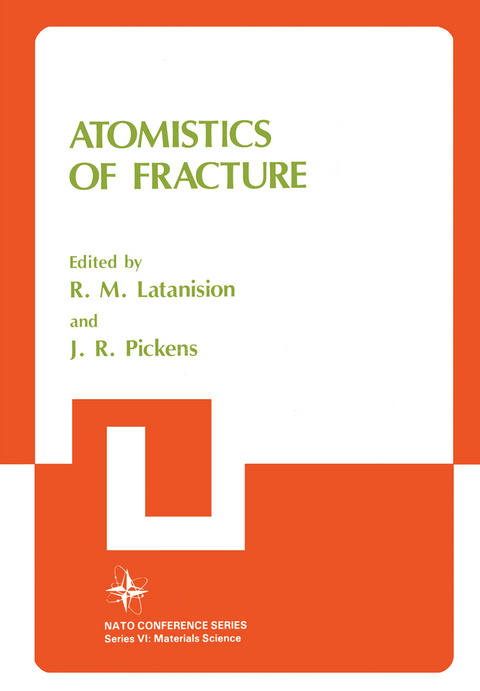
Atomistics of Fracture
Springer-Verlag New York Inc.
978-1-4613-3502-3 (ISBN)
Introductory Lectures.- General Overview: Atomistics of Environmentally-Induced Fracture.- General Overview: Atomistics of Surface Reactions.- Fracture - Applying the Breaks.- Tutorial Lectures on Fracture of Materials.- The Ideal Strength of Solids.- Physics of Fracture.- Mechanics of Fracture.- Fractography.- Tutorial Lectures on Surface Reactivity and Bonding.- Molecular Orbitals and the Atomistics of Fracture.- Cohesion and Decohesion in the Metallic Bond.- Theory of Chemisorption on Transition Metals in Relation with Heterogeneous Catalysis.- Relations between Fracture and Coordination Chemistry.- Hydrogen Adsorption on Metal Surfaces.- Adsorption on Metal Surfaces: Some Key Issues.- Interactions between Adsorbed Species and Strained Crystals.- Tutorial Lectures on Interfaces.- Nonequilibrium Surface and Interface Thermodynamics.- On the Structure of Grain Boundaries in Metals.- Interfacial Segregation in Multicomponent Systems.- Tutorial Lectures On Solution Chemistry.- The Solid/Electrolyte Interface.- Concerning Adsorbed and Absorbed Hydrogen on and in Ferrous Metals.- Electrochemically Obtained Information Concerning the Atomistics of Fracture in the Presence of Moisture.- Occluded Corrosion Cells and Crack Tip Chemistry.- The Growth of Surface Films in Electrolytes.- New Concepts in Atomistics of Fracture.- Computer Modeling of Cracks.- Electronic Processes at Dislocation Cores and Crack Tips.- Workshop Session 1: Hydrogen Embrittlement.- Hydrogen Related Fracture of Metals.- On the Transport of Hydrogen by Dislocations.- Contributed Papers:.- Hydride Formation and Redistribution in Zr-2.5 wt% Nb Stressed in Torsion.- The Hardening and Softening Induced by Hydrogen in Carbon Steels.- Diffusion of Hydrogen Near An Elasto-Plastically Deformed Crack Tip.- The Importance of Transient Effects Resulting from Dislocation Transport of Hydrogen.- Dislocation Transport of Hydrogen in Steel.- Hydrogen Assisted Crack Growth in High Purity Low Pressure Hydrogen Gas.- Effects of Crack Flank Oxide Debris and Fracture Surface Roughness on Near-Threshold Corrosion Fatigue.- Workshop Summary.- Workshop Session 2: Intergranular Embrittlement.- Atomistic Mechanisms of Intergranular Embrittlement.- Contributed Papers:.- About Intergranular Fracture of Hydrogenated Pure Metals.- Relative Effects of S, Sb, and P on the Intergranular Fracture of Iron and Nickel Tested at Cathodic Potentials.- A Comparative Study of the Influence of Rare Earth and Molybdenum Additions on the Temper Embrittlement Characteristics of a Low Alloy Steel.- The Effect of Sulphur on Hydrogen Recombination on Iron.- Workshop Summary.- Workshop Session 3: Liquid Metal Embrittlement.- Liquid and Solid Metal Embrittlement.- Nucleation and Egress of Dislocations at Crack Tips.- Workshop Summary.- Workshop Session 4: Stress Corrosion Cracking.- Stress Corrosion Cracking.- Contributed Papers:.- On the Propagation of Transgranular Stress-Corrosion Cracks.- The Embedded Disk Pressure Test (DPT): A Sensitive Technique to Investigate Materials Embrittlement.- H2S Adsorption on Plastically Strained Iron.- Workshop Summary.- Summary Session.- Atomistics of Fracture, a Conference Summary.- Contributed Papers:.- The Adsorbate-Substrate Bond and Stress-Relief Near a Crack Tip.- Crack-Tip Blunting versus Cleavage Extension.- A Comment on the Interpretation of The Griffith’s Surface Energy in Terms of Lattice Vibrations.- Participants.- Photographs of Conference.
| Reihe/Serie | Nato Conference Series ; 5 | VI Materials Science |
|---|---|
| Zusatzinfo | 141 Illustrations, black and white; XV, 1074 p. 141 illus. |
| Verlagsort | New York, NY |
| Sprache | englisch |
| Maße | 170 x 244 mm |
| Themenwelt | Naturwissenschaften ► Physik / Astronomie ► Allgemeines / Lexika |
| ISBN-10 | 1-4613-3502-7 / 1461335027 |
| ISBN-13 | 978-1-4613-3502-3 / 9781461335023 |
| Zustand | Neuware |
| Haben Sie eine Frage zum Produkt? |
aus dem Bereich


